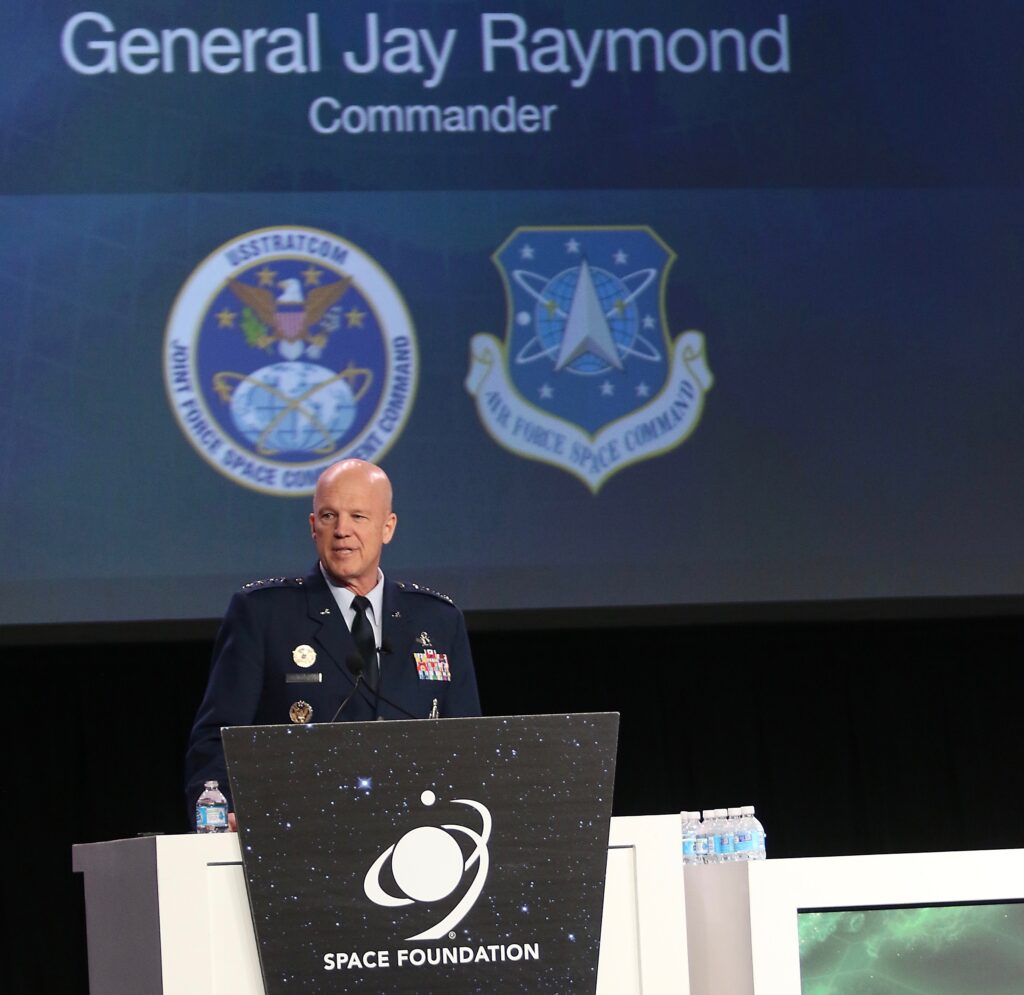Air Force Teams With NRO For Secret SSA Bird
Posted on

Gen. Jay Raymond
SPACE SYMPOSIUM: After years of missed deadlines, cost overruns and underperformance the Air Force has split the requirements for the troubled Joint Mission System program’s Increment 3, dividing them between the Coalition Space Operations Center and the National Space Defense Center. In a separate but apparently related action, the Air Force has also partnered with the nation’s spy satellite builder to create a new Space Situational Awareness satellite.
Gen. Jay Raymond, the head of Air Force Space Command and the Joint Force Space Component Commander at Strategic Command, outlined these two program shifts here in his speech this morning. He noted that AFSPC wrote a command and control Concept of Operations (CONOPS) and a situation and warning CONOPS with the NRO.
“From that (C2) CONOPS we then canceled a program that we were building because it wasn’t going to meet our mission needs, and we entered into a partnership with the NRO on a joint space situational awareness program,” Raymond said in his speech. “It will get better capability that meets our mission needs on orbit at a cheaper cost than what we had in the past.” That’s the new SSA satellite.
The other change Raymond outlined in his speech is that the Air Force is “transitioning” to a new system, ESBMC2 — Enterprise Space Battle Management Command & Control — from JMS Increment 3 that will apparently be able to manage much more Space Situational Awareness data from a wider array of sensors and work seamlessly with the Intelligence Community.
The Joint Mission System is designed as the principal source of knowledge about where and when satellites are in orbit. But it can’t handle the enormous amount of data that will soon become available thanks to the Space Fence — roughly four times as much data as it currently absorbs — and it isn’t designed for offensive and defensive space operations. Those are the ambit of the National Space Defense Center, the US government’s space warfighting center.

NRO headquarters, fondly known as the Four Towers
The original Request For Information (RFI) for ESBMC2 makes clearer how close the system’s ties are to the National Reconnaissance Office, secretive builder and operator of America’s spy satellites, and to what is now known as the National Space Defense Center, formerly called JICSpOC. It notes that “JICSpOC will leverage existing JSpOC systems and integrate them with new capabilities to better enable unity of effort between the Department of Defense and the IC for space operations. ESBMC2 system scope extends past the JSpOC alone; the program office envisions that any capabilities developed will also support the JICSpOC.”
The JICSPOC experiments validated the need for a new warfighting space strategy in 2016 to address the increasing threat. It required, Air Force officials say, “a more dynamic, warfighting C2 system that was based on an open architecture systems with defined message standards, enabling us to rapidly on-board planning and tasking software applications.” ESBMC2 program will provide those. It is funded out of the JMS program line. JMS Increment 2 is still in development and provides key SSA planning and tasking within the ESBMC2 system while supporting safety of flight missions.
ESBMC2 is being developed by AFRL, RCO and SMC.
These decisions reflect the increasing integration of operations and personnel between the military and the Intelligence Community for space operations. Breaking Defense readers will remember the National Space Defense Center, which first brought together the Air Force and NRO. The NRO had resisted closer ties for several years and only began joint operations with Air Force and other military after being subjected to persistent pressure by then-Deputy Defense Secretary Bob Work and his boss, Secretary Ash Carter.
The reason for the “transitioning” away from Increment 3 is the greatly increased range and types of threats, Air Force officials say. Also, the Joint Mission System faced “critical deficiencies” and needed beefier cyber defenses, according to the most recent Pentagon’s annual Operational Test and Evaluation report. That may well have played some role in the Air Force’s decision.
One of the policy decisions that tells you how well a program is doing is who controls Milestone Decision Authority, the legal right to make decisions on a program’s progress. Here are the five programs the Air Force does not have Milestone Decision Authority for: OCX, EELV, ESBMC2 (the new system), JMS Increment 2 and WCS. For now, the Office of the Secretary of Defense is keeping those high-risk efforts under its direct oversight.
Subscribe to our newsletter
Promotions, new products and sales. Directly to your inbox.
